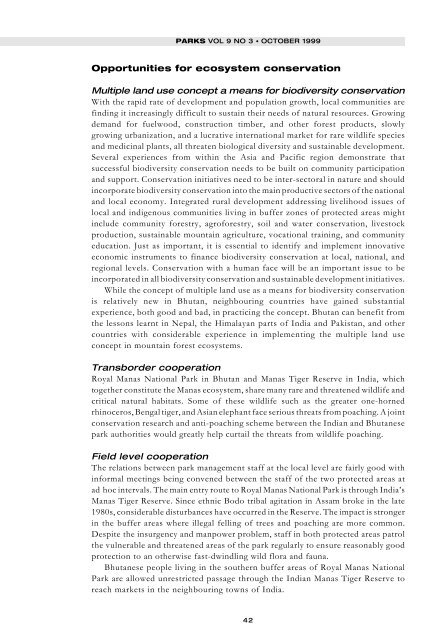Parks - IUCN
Parks - IUCN
Parks - IUCN
You also want an ePaper? Increase the reach of your titles
YUMPU automatically turns print PDFs into web optimized ePapers that Google loves.
PARKS VOL 9 NO 3 • OCTOBER 1999<br />
Opportunities for ecosystem conservation<br />
Multiple land use concept a means for biodiversity conservation<br />
With the rapid rate of development and population growth, local communities are<br />
finding it increasingly difficult to sustain their needs of natural resources. Growing<br />
demand for fuelwood, construction timber, and other forest products, slowly<br />
growing urbanization, and a lucrative international market for rare wildlife species<br />
and medicinal plants, all threaten biological diversity and sustainable development.<br />
Several experiences from within the Asia and Pacific region demonstrate that<br />
successful biodiversity conservation needs to be built on community participation<br />
and support. Conservation initiatives need to be inter-sectoral in nature and should<br />
incorporate biodiversity conservation into the main productive sectors of the national<br />
and local economy. Integrated rural development addressing livelihood issues of<br />
local and indigenous communities living in buffer zones of protected areas might<br />
include community forestry, agroforestry, soil and water conservation, livestock<br />
production, sustainable mountain agriculture, vocational training, and community<br />
education. Just as important, it is essential to identify and implement innovative<br />
economic instruments to finance biodiversity conservation at local, national, and<br />
regional levels. Conservation with a human face will be an important issue to be<br />
incorporated in all biodiversity conservation and sustainable development initiatives.<br />
While the concept of multiple land use as a means for biodiversity conservation<br />
is relatively new in Bhutan, neighbouring countries have gained substantial<br />
experience, both good and bad, in practicing the concept. Bhutan can benefit from<br />
the lessons learnt in Nepal, the Himalayan parts of India and Pakistan, and other<br />
countries with considerable experience in implementing the multiple land use<br />
concept in mountain forest ecosystems.<br />
Transborder cooperation<br />
Royal Manas National Park in Bhutan and Manas Tiger Reserve in India, which<br />
together constitute the Manas ecosystem, share many rare and threatened wildlife and<br />
critical natural habitats. Some of these wildlife such as the greater one-horned<br />
rhinoceros, Bengal tiger, and Asian elephant face serious threats from poaching. A joint<br />
conservation research and anti-poaching scheme between the Indian and Bhutanese<br />
park authorities would greatly help curtail the threats from wildlife poaching.<br />
Field level cooperation<br />
The relations between park management staff at the local level are fairly good with<br />
informal meetings being convened between the staff of the two protected areas at<br />
ad hoc intervals. The main entry route to Royal Manas National Park is through India’s<br />
Manas Tiger Reserve. Since ethnic Bodo tribal agitation in Assam broke in the late<br />
1980s, considerable disturbances have occurred in the Reserve. The impact is stronger<br />
in the buffer areas where illegal felling of trees and poaching are more common.<br />
Despite the insurgency and manpower problem, staff in both protected areas patrol<br />
the vulnerable and threatened areas of the park regularly to ensure reasonably good<br />
protection to an otherwise fast-dwindling wild flora and fauna.<br />
Bhutanese people living in the southern buffer areas of Royal Manas National<br />
Park are allowed unrestricted passage through the Indian Manas Tiger Reserve to<br />
reach markets in the neighbouring towns of India.<br />
42

















